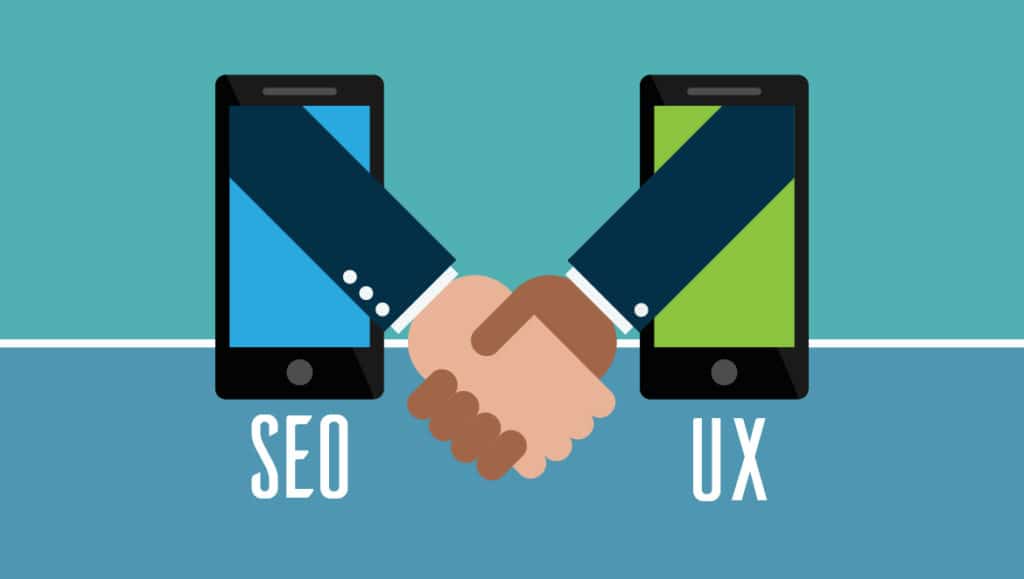This is a guest article contributed by Milosz Krasiński.
“People ignore design that ignores people.” – Frank Chimero

Website rankings and visibility are no longer down to just SEO or UX. There was a time when these two were at odds, and no one thought they would be able to work together. For those in the design world it can be a bit of a pain; gone are the days when it was simply down to a simple yet gorgeous website layout.
Now, there is more to the puzzle than we originally thought. Of course, the tension still remains in some areas because there is no such thing as true perfection in any corner of the world. Recently, however, more and more of us have been working harder to overcome this. So, why are UX and SEO the perfect partners in crime? What are the sources of tension between them? Kick back and let me take you through the process.
What You Will Learn
What will you be learning about in this handy guide? To make navigation easier for you (UX, you could say), I have a quick rundown of each of the chapters:
- Page consolidation and segmentation
- The five-second rule
- Myths around user research
- How UX impact SEO
- Keywords and anchor text
- Internal linking and navigation
- Crawler readable content
The Five Second Rule
“Fix User Experience Inefficiencies Before Expanding Your Marketing” – Mike Sadowski of Brand24
I’m sorry to disappoint, this isn’t about food. It is, however, all about that relationship between UX and SEO. I’m going to explain what this rule is very quickly, and it is that when you find yourself in a situation where you have the urge to do something uncomfortable, you have five seconds to act on it. This is how long it takes for your brain to take over and rationalise the situation. It’s something that can easily be applied to design work and UX, because designing better often comes through impulse.
What is this website about? Is it house removals only? Where it is located?
It widens your horizons in many ways, it opens you up to new experiences because you are no longer afraid of coming across as less intelligent or as though you have little to contribute. You will find yourself asking more questions about the design, the users, and the situation, but you will also be better at listening to others. There are so many great examples out there of how being impulsive can positively impact your work.
Myths Around User Research
User research is all about getting in touch with the people you are supposed to be selling to, learning what they like and what they hate. It’s a vital part of UX, because it refers to the customer wants and experience. Interestingly, however, there are quite a few myths about this handy technique that are floating around the web. Let’s take a look at a few.
#1 User research is optional
No, it is not. If you believe it is optional and you go out there without any idea of what you are doing, you are risking everything. What you think you know about your market is not always right, and user research can show you that. If you want to create something that people actually want and need, you have to invest the time in the proper research.
#2 If my friends like it, so will everyone else
There are a couple of reasons why this is wrong. First, your friends and family love you and they might just lie to you in order to make you feel good. Secondly, they may not even be your target market, in which case their opinions are useless. Third, they likely have similar tastes to you which, again, makes their opinions invalid. Are they great for enthusiastically spreading the word? Yes. Are they good for user research? Absolutely not.
#3 User research will set my project back
Actually, not doing user research is going to push you back and waste time. Yes, time will be spent on user research. However, it is exceptionally valuable time that you will be able to make use of gaining handy results about your target market. A project that fails because it was not backed by research costs a lot more time and money.
#4 Marketing is the same thing, right?
In a sense, there is some truth here because marketing does focus on brand perception and user attitude. However, user research is all about their experience and the reason why they made the choice they did. One cannot be around without the other, and they are too important to try and merge together. This isn’t something that you can just leave to the marketing team; you have to undertake the user research yourself.
The Web Doesn’t Just Focus on UX
“The next big thing is the one that makes the last big thing usable.” – Blake Ross
As a designer, it often makes sense to place all of the user intents in one place when creating a webpage. It makes it easy for the customer to find all the information they need, and the process is a lot faster. It’s faultless, but only from a UX point of view. When you bring SEO into the picture it is far less effective.
Why though? Well, it’s because the majority of your traffic is going to be coming to you through Google. Yes, there might be other search engines too, but Google is the most popular and commonly used. The visitors are going to be searching for multiple queries, and if they are all in one place it will negatively impact SEO.
They should be spread neatly over a number of different pages, and there should be specific landing pages created for each. Internal linking must be implemented as well in order to better connect various keywords and queries. It does mean you have more work to do in terms of design, but there is also so much more freedom to really implement your vision.
How Does Changing UX Affect SEO?
Many of us ignore the fact that UX is able to impact our search engine rankings, and it doesn’t really come up as often as it should. You see, Google is very specific about the way it organises and categories websites and content, so everything you do that affects the UX will have an impact on the SEO. It could be positive or negative, but either way, it ends up being a snowball effect.
Most of the time, a positive change will create a positive effect, and they work quite well together. However, there are some cases where they cause tension and strain instead. In the following chapters, I will be exploring this in detail, but before I do here are some of the main UX changes that affect SEO:
- Spam
- Links
- Content
- User/Usage Data
- Technical Issues
With these, if it is a positive change, it will have a positive impact on the SEO, and if it is negative, it will be the same. However, there are a few exceptions, and these are what cause tension. So, take some time to read below and learn more about how you can resolve it.
Local Bookkeeper – Shmunky https://shmunky.co.uk/
If you look at the image above, it is the perfect example of how you can get all of the necessary information for you visitors on the homepage as opposed to scattering it across the site. On this page, there is a live chat pop-up that allows you to contact the company directly instead of making your way over to the designated contact page. It’s a user-friendly design that will positively impact the SEO, allowing the two to work together in harmony. One less click makes everything easier and more efficient for your customers.
Keywords and Anchor Text: They Matter
Substance; the people want substance. Would you rather be served a full English with all the trimmings, or half portions of the basic ingredients while spending the same money on each? You’d pick the bigger one for the same money, and that’s what happens when you combine UX and SEO to create anchor text. It gives your visitors more information, and it helps your rankings massively.
So, what are the things you should be adding to make sure customers are engaged and that your anchor text offers more details? Well, here’s my quick rundown:
- Information about what your company is, how it came to be, and what you do
- Videos and stock images
- Keywords that are naturally inserted into the text
- Phrases and words that Google expects people to search for
Internal Linking and Site Navigation: Keep it Simple
I brushed on internal linking a moment ago, and it is important. However, you need to remember this common phrase; KISS. Keep it Simple, Stupid. It might not feel this way at first, because UX and SEO together mean that more links are needed, but keeping it simple is actually the best way to go ahead.
Again, if you are solely focusing on UX, then things are a lot simpler. You don’t need as many links because there are less pages, and you can assume that your customers are able to find things easily. However, this is not the case when you are using UX and SEO together.
Due to the fact you have more landing pages and sub-pages, you are going to have more internal links. While designing the website you are going to need to consider things like drop-down lists, footers, headers, and sidebar navigation.
Everything needs to be clearly visible, and the anchor text that is implemented must be excellent quality as well as informative. You have to assume the customer has a lower level of intuition than you, because that is how you create a layout that is customer friendly and gets good results.
Number of anchor texts – York St John University.
Crawler Readability is Important
“Design is everywhere. From the dress you’re wearing to the smartphone you’re holding, it’s design.” – Samadara Ginige
Now, the final chapter, the content itself. If you are looking at this from a UX angle, then just using videos and images is not going to work. Does it look beautiful and give customers a nice experience? Yes. Does it work with SEO? Not at all. You don’t need to load it up with loads of information, just the essentials. To give you an idea of what makes a page crawler readable, take a quick look at this list:
- Descriptive and quality content
- Strong navigation with internal links
- Strong anchor text between pages
- Keywords that have been well researched
To Conclude
As a designer, the UX often comes first. Yes, user experience is important, but if you don’t take SEO into account then everything becomes pointless. Search engines are the main way you will gain new traffic, and they need to be catered for when you are building the perfect website. It’s not hard though, and all you really need to do is follow the points listed above if you want to create something that implements the best of both worlds.
—
Written by Milosz Krasiński and Craig Cambell.






Hi Jacob, While searching on the Google I found this amazing website One of the Best post I have come across with. It is very beneficial for websites to rank naturally. Thank you very much for explaining the whole process in a detailed manner and in an efficient way.